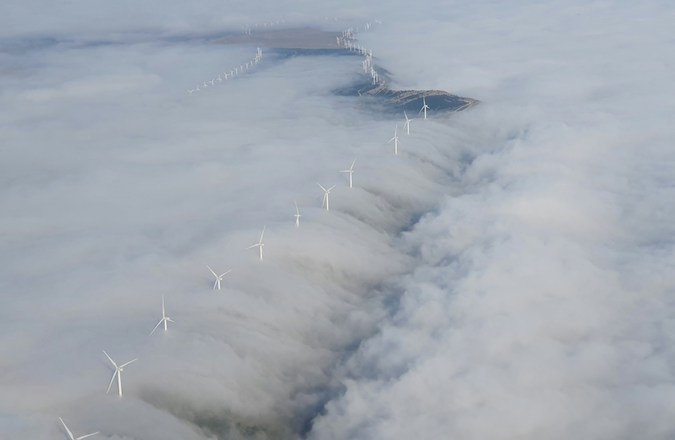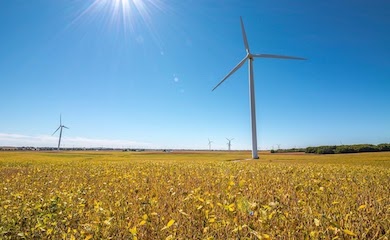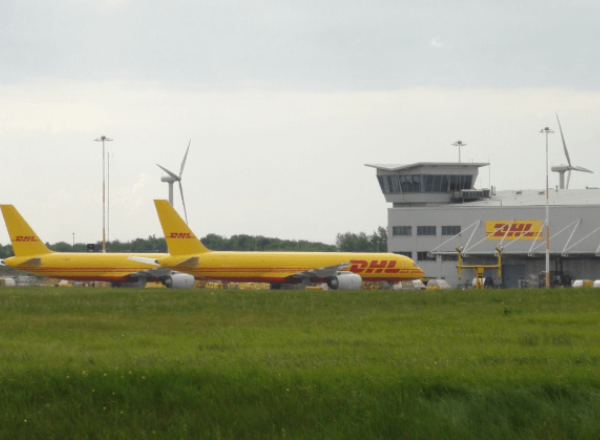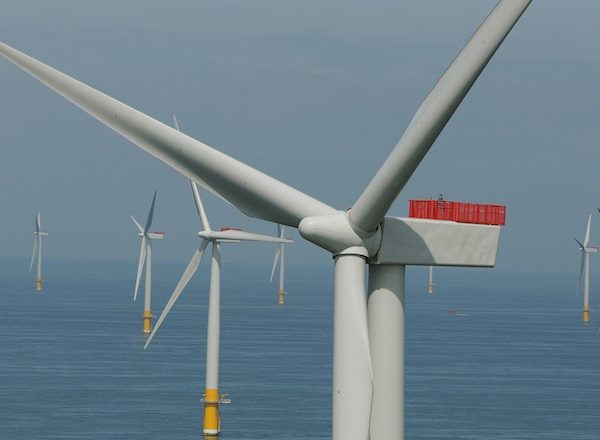When a turbine spins, it disrupts the flow of wind and creates swirling trails of disturbed air called wakes [1]. This means that it leaves slower but more turbulent air behind it. These winds are evolving vortices that can stretch for hundreds of meters and shape how much energy the next turbine can extract. They twist, they bend, and they interact. Two wakes from adjacent turbines may spiral together, separate, or even superimpose into new patterns, and it all depends on the atmosphere, terrain, and layout [2].
Photo by Fabrice Smet (2019) on Unsplash.
The Role of Terrain in Wake Behaviour
Wakes left behind by the wind turbine are akin to white water behind a boat. If another turbine is placed downwind, it has to deal with this chaotic air. This wind would spin less efficiently, wear down faster, and produce less energy. In a tightly packed wind farm, these interactions add up fast and reduce the overall energy generation significantly [3]. Terrain adds another layer of complexity. The wake behaviour is somewhat predictable over flat land. But the air doesn’t behave predictably in real-world wind farms [4]. When wind flows over forests, cliffs and other uneven terrain, the atmosphere becomes layered and uneven [5], [6].
Topology: A New Tool for Turbulence Prediction
This is where topology comes in. Topology, also known as rubber sheet geometry, is a branch of mathematics that studies shapes, surfaces and focuses on how objects twist and connect [7]. If geometry is about measuring a coffee cup, topology asks what happens if you twist it, bend it, or stretch it into a donut shape. Research in fluid dynamics, knot theory, and vortex modelling proves that topology can be used to track and categorise how air streams loop and collide, which helps predict the evolution of turbulence.
From Equations to Visualisation: Modelling Wake Dynamics
The topology modelling begins with breaking down the wake structures into discrete mathematical components by using computational fluid dynamics (CFD) software such as OpenFOAM or ANSYS [8], [9], [10]. These tools simulate the airflow dynamics, wake generation, and vortex shedding around individual turbines.
Topological data analysis (TDA) is applied to study the vortex structures using tools like Persistent Homology or Dionysus [11], [12]. The analysis captures and quantifies the wake flow features that persist over time. These methods help track how vortex filaments change within the turbulent wake. They identify important features like linking, knotting, and braiding behaviours. which are crucial for understanding how turbulence moves through the wind farm.
Once the vortex behaviours are identified and mapped, 3D flow visualisation techniques are used to create a spatial representation of the wake dynamics. Tools such as Paraview or Tecplot are used to visualise and model the wake braids in three dimensions [13], allowing researchers to see how vortex knots merge, split, or dissipate as they interact with varying terrain and atmospheric conditions. By generating these 3D models, researchers can simulate how wakes will evolve in the presence of real-world variables like wind speed, topography, and atmospheric pressure gradients [14].
Thus, these 3D models aid in creating a more optimised wind farm layout. The spacing, direction, and operating settings of the turbines can be adjusted to reduce turbulence and wear. By using topological methods and computer tools, a detailed model of how the wake behaves is created. This ensures higher energy output, longer turbine lifespans, and lower maintenance costs and downtime. Think of it as air traffic control for the invisible highways between turbines, and topology is giving us the GPS.
About Pager Power
Pager Power undertakes technical assessments for developers of renewable energy projects and tall buildings worldwide. For more information about what we do, please get in touch.
References
[1] ‘Wake effect impact on offshore wind energy | Business Norway’. Accessed: Apr. 15, 2025. [Online]. Available: https://businessnorway.com/articles/wake-effects-and-how-they-impact-wind-turbine-performance
[2] S. Lee et al., ‘Coalescing Wind Turbine Wakes’, J. Phys. Conf. Ser., vol. 625, p. 012023, Jun. 2015, doi: 10.1088/1742-6596/625/1/012023.
[3] M. Magnusson and A.-S. Smedman, ‘Air flow behind wind turbines’, J. Wind Eng. Ind. Aerodyn., vol. 80, no. 1, pp. 169–189, Mar. 1999, doi: 10.1016/S0167-6105(98)00126-3.
[4] H. Sun, H. Yang, and X. Gao, ‘Investigation into wind turbine wake effect on complex terrain’, Energy, vol. 269, p. 126767, Apr. 2023, doi: 10.1016/j.energy.2023.126767.
[5] F. I. Pacheco de Sá Sarmiento, J. L. Goes Oliveira, and J. C. Passos, ‘Impact of atmospheric stability, wake effect and topography on power production at complex-terrain wind farm’, Energy, vol. 239, p. 122211, Jan. 2022, doi: 10.1016/j.energy.2021.122211.
[6] A. Clifton, S. Barber, A. Stökl, H. Frank, and T. Karlsson, ‘Research challenges and needs for the deployment of wind energy in hilly and mountainous regions’, Wind Energy Sci., vol. 7, no. 6, pp. 2231–2254, Nov. 2022, doi: 10.5194/wes-7-2231-2022.
[7] ‘What is Topology? | Pure Mathematics | University of Waterloo’. Accessed: Apr. 15, 2025. [Online]. Available: https://uwaterloo.ca/pure-mathematics/about-pure-math/what-is-pure-math/what-is-topology
[8] ‘What is Computational Fluid Dynamics (CFD)? | Ansys’. Accessed: Apr. 15, 2025. [Online]. Available: https://www.ansys.com/en-gb/simulation-topics/what-is-computational-fluid-dynamics
[9] S. Ivanell, J. N. Sørensen, R. Mikkelsen, and D. Henningson, ‘Analysis of numerically generated wake structures’, Wind Energy, vol. 12, no. 1, pp. 63–80, 2009, doi: 10.1002/we.285.
[10] M. Sessarego, J. Feng, M. Friis-Møller, Y. Xu, M. Xu, and W. Zhong Shen, ‘Development of a streamline wake model for wind farm performance predictions’, J. Phys. Conf. Ser., vol. 1618, no. 6, p. 062027, Sep. 2020, doi: 10.1088/1742-6596/1618/6/062027.
[11] H. (吴慧烜) Wu, X. (陶行天) Tao, and Z. C. (郑钟泉) Zheng, ‘A persistent homology method with modified filtration to characterize the phase trajectory of a turbulent wake flow’, Phys. Fluids, vol. 33, no. 2, p. 025118, Feb. 2021, doi: 10.1063/5.0033509.
[12] L. Smith, K. Fukami, G. Sedky, A. Jones, and K. Taira, ‘A cyclic perspective on transient gust encounters through the lens of persistent homology’, J. Fluid Mech., vol. 980, p. A18, Feb. 2024, doi: 10.1017/jfm.2024.16.
[13] ‘4. Visualizing Large Models — ParaView Documentation 5.12.0 documentation’. Accessed: Apr. 15, 2025. [Online]. Available: https://docs.paraview.org/en/latest/Tutorials/SelfDirectedTutorial/visualizingLargeModels.html
[14] R. Brogna, J. Feng, J. N. Sørensen, W. Z. Shen, and F. Porté-Agel, ‘A new wake model and comparison of eight algorithms for layout optimization of wind farms in complex terrain’, Appl. Energy, vol. 259, p. 114189, Feb. 2020, doi: 10.1016/j.apenergy.2019.114189.




